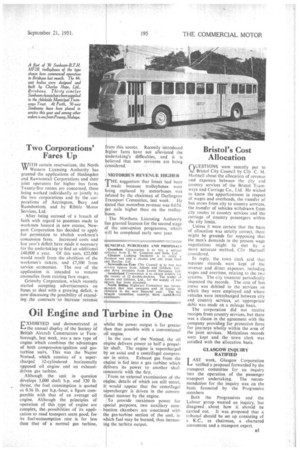Oil Engine and urbine in One
Page 37

If you've noticed an error in this article please click here to report it so we can fix it.
EXHIBITED and demonstrated at the annual display 'of the Society 'Of British Aircraft Constructors at Farro borough, last week, was a new type of engine which combines the advantages of both compression-ignition and gasturbine units. This was the Napier Nomad, which consists of a supercharged 12-cylindered horizontally opposed oil engine and an exhaustdriven gas turbine.
Although the unit in question develops 3,000 shaft h.p, and 320 lb. thrust, the fuel consumption is quoted as 0.36 lb. per h.p.-hour, a figure comparable with that of an average oil engine. Although the principles of operation of this type of engine are complex, the ,possibilities of its application to road transport seem good, for its fuel-consumption rate is far less than that of a normal gas turbine, hilst the power output is far greater t an that possible with a conventional o 1 engine.
In the case of the Nomad, the oil e gine delivers power to half a propelI r shaft. The engine is supercharged b an axial and a centrifugal compres in series. Exhaust gas from the e gine is fed into a gas turbine which d livers its power to another shaft • ncentric with the first.
From an external examination of the
e gine, details of which are still secret, it would appear that the centrifugal s percharger is driven in the conventional manner by the engine.
To provide maximum power for s ecial purposes, two auxiliary cornstion chambers are associated with c gas-turbine section of the unit, in ich fuel may be burned, thus increas i g the turbire output. '




























































































